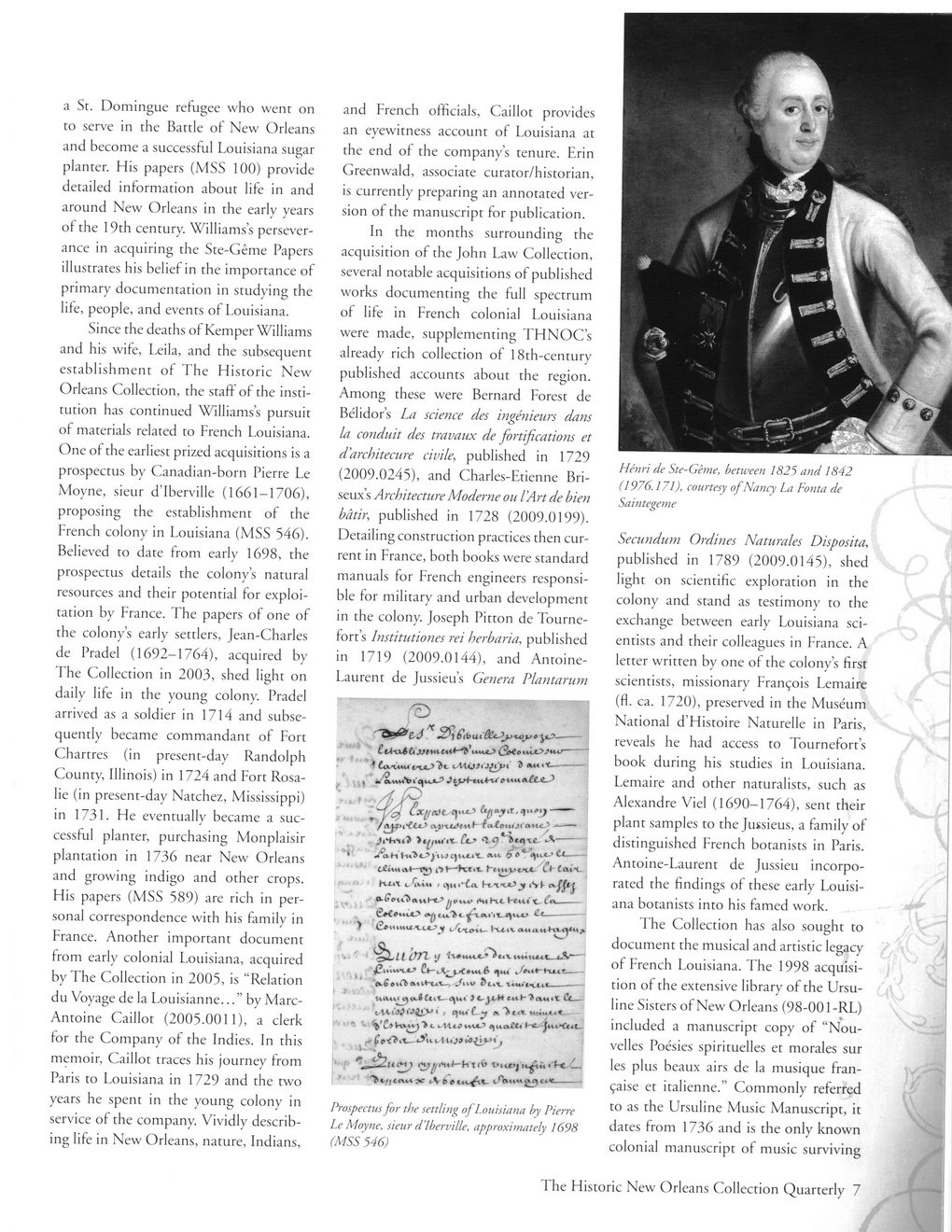This text was obtained via automated optical character recognition.
It has not been edited and may therefore contain several errors.
a St. Domingue refugee who went on to serve in the Battle of New Orleans and become a successful Louisiana sugar planter. His papers (MSS 100) provide detailed information about life in and around New Orleans in the early years of the 19th century. Williams’s perseverance in acquiring the Ste-Geme Papers illustrates his belief in the importance of primary documentation in studying the life, people, and events of Louisiana. Since the deaths of Kemper Williams and his wife, Leila, and the subsequent establishment of The Historic New Orleans Collection, the staff of the institution has continued Williams’s pursuit of materials related to French Louisiana. One of the earliest prized acquisitions is a prospectus by Canadian-born Pierre Le Moyne, sieur d’Iberville (1661-1706), proposing the establishment of the French colony in Louisiana (MSS 546). Believed to date from early 1698, the prospectus details the colony’s natural resources and their potential for exploitation by France. The papers of one of the colony’s early settlers, Jean-Charles de Pradel (1692-1764), acquired by The Collection in 2003, shed light on daily life in the young colony. Pradel arrived as a soldier in 1714 and subsequently became commandant of Fort Chartres (in present-day Randolph County, Illinois) in 1724 and Fort Rosalie (in present-day Natchez, Mississippi) in 1731. He eventually became a successful planter, purchasing Monplaisir plantation in 1736 near New Orleans and growing indigo and other crops. His papers (MSS 589) are rich in personal correspondence with his family in France. Another important document from early colonial Louisiana, acquired by The Collection in 2005, is “Relation du Voyage de la Louisianne...” by Marc-Antoine Caillot (2005.0011), a clerk for the Company of the Indies. In this memoir, Caillot traces his journey from Paris to Louisiana in 1729 and the two years he spent in the young colony in service of the company. Vividly describing life in New Orleans, nature, Indians, and French officials, Caillot provides an eyewitness account of Louisiana at the end of the company’s tenure. Erin Greenwald, associate curator/historian, is currently preparing an annotated version of the manuscript for publication. In the months surrounding the acquisition of the John Law Collection, several notable acquisitions of published works documenting the full spectrum of life in French colonial Louisiana were made, supplementing THNOC’s already rich collection of 18th-century published accounts about the region. Among these were Bernard Forest de Belidor’s La science des ingenieurs dans la conduit des travaux de fortifications et d'architecure civile, published in 1729 (2009.0245), and Charles-Etienne Bri-seux’s Architecture Moderne ou I’Artde bien batir, published in 1728 (2009.0199). Detailing construction practices then current in France, both books were standard manuals for French engineers responsible for military and urban development in the colony. Joseph Pitton de Tourne-fort’s Institutiones rei herbaria, published in 1719 (2009.0144), and Antoine-Laurent de Jussieu’s Genera Plantarum £.3 ------- ** * & ----------------------------------------------- 9 cyMtJe+t1~ ’fa-totu Ji'avtt? 1 Ct-> <1 9 ^ * ------------------------------------------------ Y'cittyiiA- Ct~ Cm-c fvtix t K-1'Cy »Sr|- 1H1 Kt WuV c --------- (£#€*Vi.vO <?LQ —------- ^ f Ktlt I I (Trt tj t/WitlXit__iStT" 0b 6 » OH ----------- ittutruja-lCtit- c\ui 3 e^t t-cvm • 1 C*— 1 t quit. y u+iun* “■ ^ 'fr «. wVl^uoi?&4 Ht- C- , / - \ H't tto — :*c c% 6ac*v^it. ----- Prospectus for the settling of Louisiana by Pierre Le Moyne, sieur d'Iberville, approximately 1698 (MSS 546) Henri de Ste-Geme, between 1825 and 1842 (1976.171), courtesy of Nancy La Fonta de Saintegeme Secundum Ordines Naturales Disposita, published in 1789 (2009.0145), shed light on scientific exploration in the colony and stand as testimony to the exchange between early Louisiana scientists and their colleagues in France. A letter written by one of the colony’s first scientists, missionary Francois Lemaire (fl. ca. 1720), preserved in the Museum National d’Histoire Naturelle in Paris, reveals he had access to Tournefort’s book during his studies in Louisiana. Lemaire and other naturalists, such as Alexandre Viel (1690-1764), sent their plant samples to the Jussieus, a family of distinguished French botanists in Paris. Antoine-Laurent de Jussieu incorporated the findings of these early Louisiana botanists into his famed work. The Collection has also sought to document the musical and artistic legacy of French Louisiana. The 1998 acquisition of the extensive library of the Ursu-line Sisters of New Orleans (98-001-RL) included a manuscript copy of “Nou-velles Poesies spirituelles et morales sur les plus beaux airs de la musique franchise et italienne.” Commonly referred to as the Ursuline Music Manuscript, it dates from 1736 and is the only known colonial manuscript of music surviving The Historic New Orleans Collection Quarterly 7

New Orleans Quarterly 2011 Fall (07)